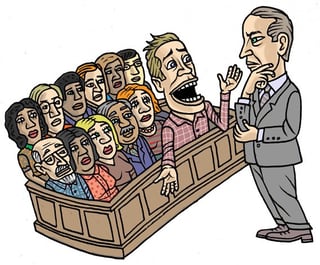August 2, 2016
Voir dire can be an intimidating situation for the attorney—but just think what it is like for the potential jurors. Answering questions, often of a personal nature, in open court, in front of their fellow jurors, the judge, attorneys, and even the media can make anyone nervous and reluctant to talk. But talk they must if we are to have a useful voir dire. Sure, you can ask potential jurors questions and hope that you get everyone to talk. And, of course, you have seen Tip 1 and are ready to have a conversation with the jurors once they talk. But it is hard to have everyone talk at the beginning . . . or is it? (Click here to see a short video for this tip.)
Initial Background Summary
When faced with the intimidating nature of the voir dire questioning process, what can we do to encourage jurors to participate (both through talking and raising hands)? One approach is to help “break the ice” with jurors by having everyone talk at the outset of voir dire. Our goal is to reduce the jurors’ initial discomfort in speaking in this public setting by giving them practice in speaking in this setting. I refer to this approach as the Initial Background Summary. The key to this approach is to have jurors answer five (5) basic questions about themselves that are relatively easy to answer and not too sensitive.
Give Me Five (Questions)
It is important to select a limited number of questions for this approach. There should be enough questions so that jurors have the experience of speaking in the group and, as a result, they feel more comfortable in doing so. However, the number should be small enough that they are easily remembered by the jurors and potential embarrassment through skipping or not remembering questions is minimized. I find that four to five questions effectively serve this purpose.
Keep to the Basics
When considering the questions to ask, stick to the basics. This is not a time for sensitive questions, questions requiring deep thought, or questions that might cause embarrassment. Our goal is to give jurors a positive and successful experience with participating (talking) in the voir dire process. Sensitive or potentially embarrassing questions are counterproductive. Questions that address basic information such as their name, occupation, marital status, or any children are useful.
Make Mine with a Twist
I like to include a final question that has a twist to it. It is a basic question but has potential to provide something beyond the basics. Asking jurors to tell you about their spare-time activities or general interests (e.g., target shooting, hunting, skydiving, civic service, volunteering at the homeless shelter, and solving crossword puzzles) can provide a more intimate level of disclosure and may provide some psychological insight into the jurors as well.
Putting it All Together
So, what does this look like on voir dire? How about the following?
(After explaining voir dire) We will be spending some time getting to know you all today. I would like to start out by having each of you tell us a little about yourself before I get into more specific questions. We will start with some basic questions.
(1) What is your name?
(2) What is your marital status at this time?
(3) If you are employed outside the home, what do you do or, if not, what do you do in the home? If you are retired or currently not employed, please tell me what you did in the past.
(4) Do you have any children, and, if so, what are their ages and genders? And
(5) What are your favorite spare-time activities and general interests?
Capitalize on Modeling
It is often helpful to model what you want from jurors. Also, such modeling increases the jurors’ willingness to tell a little about themselves (what psychologists call “disclosure reciprocity”). So, answer the same five questions to start the process. But avoid controversial answers. You don’t need to tell them that you are a political activist, enjoy vacationing in the south of France, or that your hobby is clubbing baby seals. Simply being involved in your child’s school activities (or similar noncontroversial activity) as a spare-time interest is all that is needed.
Be Supportive
Yes, in the beginning, some of the jurors will forget some of the questions. Your role at this time is to make sure you don’t embarrass them. Be supportive and prompt them with the missed question. Keep your attitude and demeanor light. It is not a test but a chance to get to know them. After a few jurors have responded, the remaining jurors should be able to remember the five Initial Background Summary questions with only the occasional prompting.
Wait, but I Go Second!
The Initial Background Summary is best applied by the first party to question the group of jurors. However, if jurors have not been forthcoming during the previous parties’ questioning (a not too infrequent occurrence), you can use this approach to jumpstart participation by jurors. Remember, the goal is to get jurors talking by making them feel comfortable in doing so. So, why not ask jurors to go through the same exercise but with questions that have not been covered by the opposing counsel? For example, topics such as the length of time they have lived in the community, spare-time activities and interests (if not covered previously), favorite television programs, or other basic questions can be useful. However, you do not need to ask five questions. Three questions will serve your purpose.
Size Matters
The Initial Background Summary is most effectively utilized in small to medium size groups. While it can be applied in larger groups, e.g., groups of 30 or more, it can lose its impact. As we will see in our next tip, there are ways of having jurors participate at the start of voir dire that simply rely on jurors raising their hands. But we will cover that later.
We will be covering additional tips in the months to come. Check out our introductory two-minute video, Tip 1, and the video for Tip 2.
For more information on voir dire and jury selection, see Mastering Voir Dire and Jury Selection.




